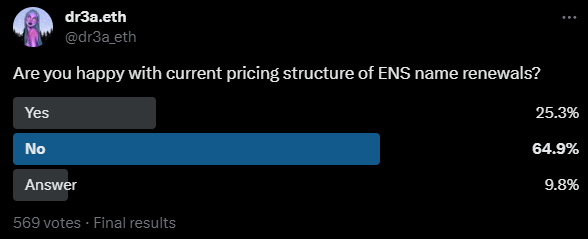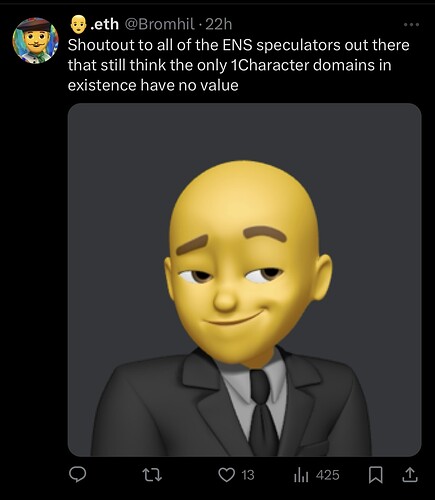Hey everyone. Long term community member, first time forum poster. ![]()
Let’s talk about that one thing. You know the one… the most recurring point of debate within the ENS community: Renewal Fees for 3L and 4L .eth Domains.
To get things started I’d like to highlight that the conversation about renewal fees is not just a passing concern. This topic has repeatedly surfaced as a key issue, indicating a deep-rooted call for change and evolution. There are several indicators of this with the most recent being strong feedback from community driven polls and even insights from thought leaders like Vitalik.eth all of which drive home one point: ENS is a critical infrastructure, and it needs to be affordable.

ENS has established itself as a key pillar in blockchain domain naming. However, its current pricing structure appears to pose significant challenges to its potential and accessibility. This proposal aims to address and rectify these challenges, seeking balance between the community’s long-term concerns as well as the foundational principles ENS was built on.
Identifying the Key Issues
A primary concern expressed typically revolves around the high renewal fees for 3L and 4L domains. While originally meant to preserve domain exclusivity and reduce speculation, these fees have inadvertently hindered the broader application and innovation within the ecosystem.
Additionally, the adoption of Unicode characters in ENS has greatly expanded possible domain combinations, but the vast majority of these combinations will remain unclaimed due to high costs, undermining ENS’s goal of being an accessible and diverse naming system.
Rationale for Proposed Pricing Adjustments
- Community Feedback: Reflecting on the community’s continuous input, it’s evident that a shift towards a more modern, inclusive, and equitable pricing model is crucial to meet evolving needs and expectations.
- Balancing Accessibility and Anti-Squatting: Our goal is to maintain accessible renewal fees while effectively deterring large-scale domain squatting, a strategy crucial for upholding the integrity and dynamism of the ENS ecosystem.
- Impact of Unicode Inclusion: With the addition of Unicode characters, the scope of 3 and 4L domains has grown exponentially, rendering the high uniform fees increasingly exorbitant. Such a broad spectrum of possibilities should not be restricted by such steep pricing, as it discourages the registration of many innovative domains, narrowing the field of what’s accessible within the ecosystem.
- Encouraging Active Domain Use: The objective is to enhance the usage of 3L and 4L domains within ENS, thereby cultivating a more dynamic and inventive environment, and dispelling the long-held fallacy that ‘nobody NEEDs a 3 or 4L domain.’
Proposed Pricing Structure
-
3L Domains:
- Initial Fee: The initial fee for registration remains at $640, a deliberate threshold to preserve the prestige of these domains and prevent speculative short-term holding. Furthermore this fee must be paid in full at the time of registration, with no option for monthly payments, to ensure a serious commitment from registrants.
- Renewal Fee: After the initial one-year full payment, I propose reducing the annual fee to $160. This reduction aims to make premium domains more accessible for continued use and development, while still upholding a viable and proven pricing model. This new fee, applicable after the first year’s commitment, is designed to encourage lasting engagement within the ENS ecosystem.
-
4L Domains:
- Initial Fee: Maintained at $160, required to be paid in full at registration.
- Renewal Fee: Set at $80 to align with broader industry standards, supporting wider use and active development within ENS while maintaining a more expected pricepoint for premium domain renewals. It also keeps the math simple.
-
5L and Longer Domains:
- Option A: Increase to $10, doubling the effort required for speculative holding, yet remaining modest and reasonable for individual users. This change seeks to enhance the DAO’s revenue and aligns with the overall strategy to dampen the effects of widespread domain squatting.
- Option B: Keep renewals at a flat $5 for greater affordability and inclusivity, ideal for diverse participation. The less is more approach.
Recommended Post Transition Refund Mechanisms
- Option A: ‘The Right Thing’ – Automatic refunds for domain holders who have maintained their domains for at least one year, in recognition of their commitment.
- Option B: ‘The Smart Thing’ – A snapshot and claim process, balancing fiscal responsibility with the engagement of active ENS participants. This option seeks to minimize treasury losses.
Wrapping Up
This proposal isn’t just about tweaking fees to satisfy speculators; it’s about unlocking untapped potential within ENS. We’ve heard the community’s overwhelming concerns loud and clear: the high current renewal fees for 3L and 4L domains are prohibitive, while the low fees for 5L and longer domains have unintentionally encouraged squatting.
By lowering the fees for 3L and 4L domains, coupled with the prerequisite of an upfront premium commitment, we aim to address these concerns directly. Our goal is to widen participation, spur innovation, and enhance the richness of the ENS ecosystem while maintaining its overall integrity.
In addressing the community’s most persistently raised issue, this revision of the fee structure for 3L and 4L domains is not just a nod to their continued expressions. It’s a strategic and thoughtful approach to a concern that has been at the forefront of community discussions, aiming to make the ENS ecosystem more accessible and innovative for all.
We can do this better. ![]()
Thank you.
